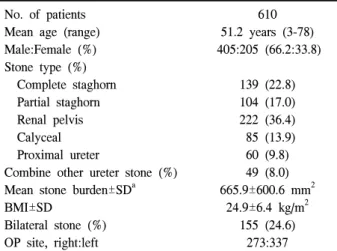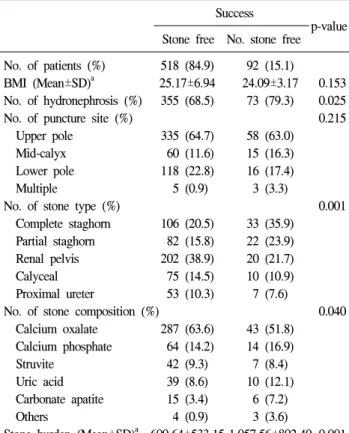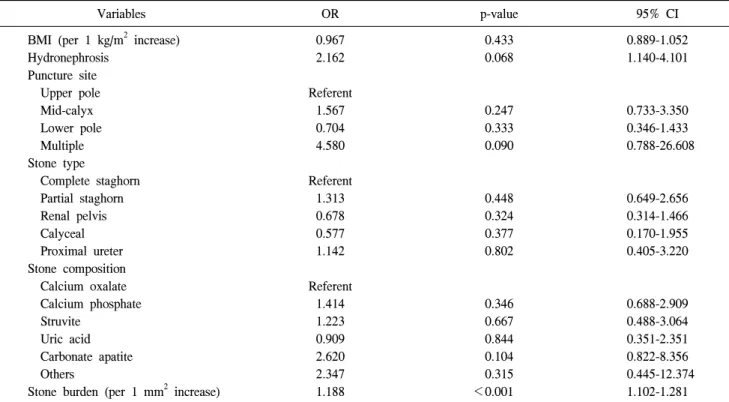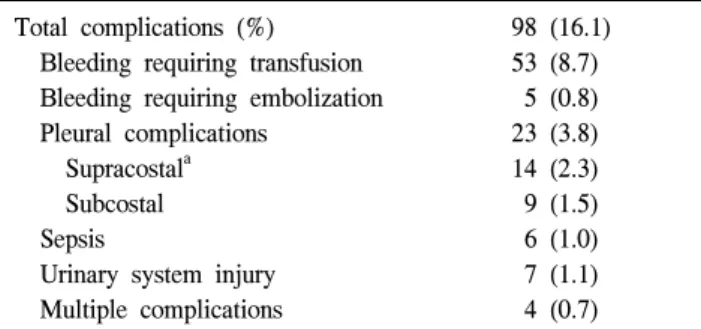669
Percutaneous Nephrolithotomy: A Single Center Experience of 610 Cases
Taekmin Kwon, Jeong Kyoon Bang, Seong Chul Kim, Myungsun Shim, Seong-Heon Ha, Bumsik Hong, Hyung Keun Park
From the Department of Urology, Asan Medical Center, University of Ulsan College of Medicine, Seoul, Korea
Purpose: We performed this study to evaluate the outcomes and com- plications of percutaneous nephrolithotomy (PCNL) at a single institute with a large series.
Materials and Methods: We reviewed the medical records of 610 patients who underwent PCNL between March 1995 and June 2008 for staghorn calculi in 139 (22.8%), partial staghorn calculi in 104 (17.0%), renal pelvis stone in 222 (36.4%), proximal ureter calculi in 60 (9.8%), and calculi within a caliceal diverticulum in 85 (13.9%) patients. Stone-free status was defined as no visible residual calcification or remnant calcification smaller than 4 mm in diameter (clinically insignificant residual fragment) on a plain KUB (X-ray examination of the kidney, ureter, and bladder) image.
Characteristics of the stones, operation time, stone-free rate, and compli- cations were evaluated.
Results: Initial stone burden was 665.9±600.6 mm2. Average operation time was 103.2±58.6 minutes. The mean hospital stay was 7.9 days. The stone- free rate was 84.9%, and ancillary procedures were required in 66 patients (10.8%), including 34 (5.6%) second-look PCNL and 26 (4.3%) ureteroscopic procedures. In the univariate analysis for prediction of stone-free rate, hy- dronephrosis, stone type, stone composition, and stone burden were signi- ficant prognostic factors. In the multivariate analysis, initial stone burden was the only independent factor affecting the stone-free rate. Complica- tions were found in 95 patients (16.1%), 5 (0.8%) of whom needed emboli- zation due to bleeding and 23 (3.8%) of whom showed pleural complications.
Conclusions: PCNL is an effective method for the treatment of staghorn, large calyceal, and some upper ureteral stones with acceptable compli- cation rates. (Korean J Urol 2009;50:669-674)
Key Words: Percutaneous nephrolithotomy, Kidney calculi, Complications
Korean Journal of Urology Vol. 50 No. 7: 669-674, July 2009 DOI: 10.4111/kju.2009.50.7.669
울산대학교 의과대학 비뇨기과학교실 권택민ㆍ방정균ㆍ김성철ㆍ심명선 하성헌ㆍ홍범식ㆍ박형근
Received:March 19, 2009 Accepted:June 30, 2009
Correspondence to: Hyung Keun Park Department of Urology, Asan Medical Center, University of Ulsan College of Medicine, 388-1, Pungnap-dong, Songpa-gu, Seoul 137-736, Korea
TEL: 02-3010-3737 FAX: 02-477-8928
E-mail: hkpark@amc.seoul.kr
Ⓒ The Korean Urological Association, 2009
서 론
1941년 Rupel1이 신루를 통한 신결석의 제거를 최초로 시 도 하였지만 최초의 경피적 신쇄석술은 1976년 Fernström과 Johansson2에 의해 이루어 졌다. 그 후 Alken 등3에 의하여 신내시경과 초음파쇄석기가 결석 치료에 도입되어 경피적 신쇄석술을 발전시키는데 기여하였다. 현재 대부분의 신결 석 치료는 충격파 쇄석술 (shock wave lithotripsy; SWL)에
의해 이루어지지만 신결석의 크기, 위치, 모양, 성분에 따라 수술적 치료가 필요한 경우가 있다. 경피적 신쇄석술은 개 복술에 비해 낮은 치료 합병증과 빠른 회복으로 2 cm 이상 의 큰 결석, 감염결석, 폐색과 동반된 결석, 시스틴석, 체외 충격파쇄석술이 실패한 경우 및 해부학적 기형이 동반된 경우 최선의 치료방법으로 보고되고 있다.4,5
경피적 신쇄석술은 신루의 형성과 확장 그리고 결석을 제거하는 3단계 과정으로 구분되는데, 이러한 과정에서 여 러 가지 합병증이 유발될 수 있고 때로는 심각한 결과가
Table 1. Patient characteristics No. of patients
Mean age (range) Male:Female (%) Stone type (%) Complete staghorn Partial staghorn Renal pelvis Calyceal Proximal ureter
Combine other ureter stone (%) Mean stone burden±SDa BMI±SD
Bilateral stone (%) OP site, right:left
610 51.2 years (3-78) 405:205 (66.2:33.8)
139 (22.8) 104 (17.0) 222 (36.4) 85 (13.9) 60 (9.8) 49 (8.0) 665.9±600.6 mm2
24.9±6.4 kg/m2 155 (24.6)
273:337
BMI: body mass index, a: applying the fomula for surface area (lengthxheight)
초래되기 때문에 시술자는 술 중, 술 후 합병증의 조기 발견 과 적절한 처치를 준비해야 한다. 저자들은 단일 기관에서 시행된 큰 환자군에 대한 경피적 신쇄석술의 의무기록을 후향적으로 분석하여 경피적 신쇄석술의 성적 및 합병증에 대하여 알아보고자 하였다.
대상 및 방법
1995년 3월부터 2008년 6월까지 경피적 신쇄석술 (percu- taneous nephrolithotomy; PCNL)을 시행 받은 환자 610명의 의무기록을 후향적으로 분석하였다. 환자들의 평균 연령은 51.2세였고, 남자가 405명 (66.2%), 여자가 205명 (33.8%)이 었다. 요석의 종류는 완전 신녹각석 139명 (22.8%), 부분 신 녹각석 104명 (17.0%), 신우석 222명 (36.4%), 근위요관석 60명 (9.8%), 신배석 85명 (13.9%)이었다. 근위요관석을 제 외한 요관석을 동반한 경우는 49명 (8.0%)에서 관찰되었고 양측 신장 모두에 결석을 가진 경우는 155명 (24.6%)에서 관찰되었다. 평균 결석 크기 (stone burden)는 665.9±600.6 mm2였다 (Table 1).
모든 환자에서 배설성 요로 조영술이나 컴퓨터단층촬영 (computerized tomography; CT)을 시행하였고 요석 장경은 단순 복부필름으로 측정하였으며 수술 전 처치로 최근 요 배양검사 결과를 근거로 하여 수술 24-36시간 전에 비경구 용 항생제를 투여하였고 요 배양 검사에서 무균상태를 보 이는 환자에는 예방적 목적으로 비경구용 항생제를 술 전 에 투여하였다.
경피적 신쇄석술은 두 명의 술자에 의해 시행되었다. 수 술은 전신마취 하에 천자와 신루 확장, 쇄석술을 1단계 수
술로 동시에 시행하였다. 경피적 천자 전에 집뇨계의 해부 학적 구조를 확인 및 조영제 투여를 위해 쇄석위에서 방광 경을 통해 5 Fr 요관 카테터를 유치하였다. 수술 중 발생한 요석조각이 요관으로 하방 이동 하는 것을 방지하기 위해 신우 요관 접합부에 5 Fr 풍선 카테터를 설치하였으며 수술 중 요 배출을 위해 도뇨관을 유치하였다. 신천자 중 늑골상 천자는 167례 (27.4%), 늑골 하 천자는 441례 (72.3%)에서 시행하였다. 그 외 2례 (0.3%)는 2개 이상의 다발성 천자를 시행하였다. 늑골상 천자의 경우 신장 상극이 제12늑골상 부에 위치한 경우 최대 호기상태에서 11번째와 12번째 늑 골 사이를 천자하였고 드물게, 신 상극이 11번째 늑골 상부 에 위치한 경우에는 중부나 하부 신배를 천자하였다. 이어 서 유도 철선을 유치한 후 주로 풍선 확장술을 이용하여 30 Fr까지 신루를 확장하였다. 드물게 풍선 확장술이 어려 운 경우 Amplatz serial dilator를 이용하였다. 쇄석은 ultra- sonic lithotriptor, ballistic lithotriptor 및 holmium: YAG laser 를 이용하여 쇄석을 시행한 후 파악 겸자를 이용하여 결석 을 제거하였다. 결석제거 후 14 Fr Malecot nephrostomy tube 를 유치하였다. 늑골상 천자 환자의 경우 회복실에서 흡기 상태에 흉부 방사선검사를 시행하였고 술 후 2일째 흉부 방사선검사를 다시 시행하여 지연성 기흉과 흉막저류 여부 를 확인하였다. 모든 환자는 술 후 혈뇨가 호전되면 (술 후 2-3일) 잔석의 여부를 확인하기 위해 신우 조영술을 시행하 였다. 치료의 성공은 수술 직후 신장, 요관, 방광-단순요로 촬영 (KUB)에서 결석이 보이지 않는 경우 (initial stone free) 와 잔석이 많지 않은 경우 체외충격파쇄석술 등을 시행하 고 술 후 4주 후 추적검사 후 4 mm 이하의 잔석이 남는 경우 (overall stone free)로 정의하였고 치료 성공률에 영향 을 미치는 인자를 분석하였다. 결석의 크기 (stone burden)와 체질량 지수 (body mass index; BMI)는 연속 변수로 Student’s t-test를 이용하였고 수신증 여부, 천자위치, 결석 형태와 결 석의 구성성분은 범주형 변수로 처리하여 chi- square test를 이용하여 검정하였으며, 로지스틱 회귀분석을 적용하여 다 변량 분석하였다. 통계분석은 PC-SPSS vesion 13.0 (SPSS, Inc, USA)을 이용하여 수행하였고, p값이 0.05 미만인 경우 에 통계학적 유의성이 있다고 판정하였다.
결 과
평균 수술시간은 103.2±58.6분이었고 신천자의 위치는 상극이 393명 (64.4%)으로 가장 많았으며, 중부 신배가 75 명 (12.3%), 하극이 134명 (22%)이었고, 8명 (1.3%)에서 2개 이상의 천자를 시행하였다 (Table 2).
평균 재원 일수는 7.9±5.5일이었다. 534명에서 술 후 결석
Table 2. Perioperative data of the patients Operation time±SD
Puncture site (%) Upper pole Mid-calyx Lower pole Multiple
103.2±58.6 min.
393 (64.4) 75 (12.3) 134 (22)
8 (1.3)
Table 3. Treatment outcomes of PCNL Hospital stay±SD
Success rate (%) (based on simple X-ray) Initial stone free rate
Overall stone freerate Ancillary procedures (%) Open surgery
Re-PCNL Ureteroscopy
Re-PCNL+ureteroscopy Others
Stone composition (%) Calcium oxalate Calcium phosphate Struvite
Uric acid Carbonate apatite Others
7.9±5.5 days 350/610 (57.6) 518/610 (84.9) 66 (10.8) 1 (0.2)
34 (5.6) 26 (4.3) 3 (0.5) 2 (0.3)
534 340 (63.7)
75 (14) 48 (8.9) 46 (8.6) 18 (3.6) 7 (1.2) PCNL: percutaneous nephrolithotomy
Table 4. Patient characteristics stratified by stone-free rate Success
p-value Stone free No. stone free No. of patients (%) 518 (84.9) 92 (15.1)
BMI (Mean±SD)a 25.17±6.94 24.09±3.17 0.153 No. of hydronephrosis (%) 355 (68.5) 73 (79.3) 0.025
No. of puncture site (%) 0.215
Upper pole 335 (64.7) 58 (63.0)
Mid-calyx 60 (11.6) 15 (16.3)
Lower pole 118 (22.8) 16 (17.4)
Multiple 5 (0.9) 3 (3.3)
No. of stone type (%) 0.001
Complete staghorn 106 (20.5) 33 (35.9) Partial staghorn 82 (15.8) 22 (23.9) Renal pelvis 202 (38.9) 20 (21.7)
Calyceal 75 (14.5) 10 (10.9)
Proximal ureter 53 (10.3) 7 (7.6)
No. of stone composition (%) 0.040
Calcium oxalate 287 (63.6) 43 (51.8) Calcium phosphate 64 (14.2) 14 (16.9)
Struvite 42 (9.3) 7 (8.4)
Uric acid 39 (8.6) 10 (12.1)
Carbonate apatite 15 (3.4) 6 (7.2)
Others 4 (0.9) 3 (3.6)
Stone burden (Mean±SD)a 600.64±533.15 1,057.56±802.40 0.001 BMI: body mass index, a: Student’s t-test
성분을 독일 Perkin-Elmer사에서 제작한 Founier-Transform Infra Red (FT-IR) spectrometer를 이용하여 정성, 정량 분석 한 결과, 칼슘석이 415례 (77.7%)로 가장 많은 비중을 차지 하였고, 감염석이 48례 (8.9%)였으며, 요산석이 46례 (8.6%) 에서 관찰되었다. 칼슘석은 수산칼슘석 (calcium oxalate)이 63.7%, 인산칼슘석 (calcium phosphate)이 14%였다. 경피적 신쇄석술 직후 결석이 완전 제거된 결석 제거율 (initial stone free rate)은 57.6%였으며, 술 후 체외충격파쇄석술은 209명 (34.2%)에서 시행되었고, 4주 추적검사 후 4 mm 이하 의 잔석이 남는 경우를 포함한 전체 치료 성공률 (overall success rate)은 84.9%였다. 66명 (10.8%)에서 경피적 신쇄석 술 시행 후 4 mm 이상의 잔석이 남아 추가 시술을 시행하 였고 경피적 신쇄석술을 재시행한 경우가 34명 (5.5%)으로 가장 많았고, 요관 내시경을 시행한 경우가 26명 (4.3%)이 었다 (Table 3).
치료 성공에 영향을 미치는 인자를 알아보기 위한 단변 량 분석에서는 수신증 여부, 결석의 형태, 결석의 구성성분 과 결석 크기가 유의한 인자였다 (Table 4). 다변량 분석에 서는 체질량지수, 수신증 여부, 천자 위치, 결석의 형태와
구성성분은 치료 성공률에 영향을 미치지 못하였다. 결석 크기만이 치료 성공률에 영향을 주는 유의한 인자였다 [odds ratio (OR)=1.188, 95%CI 1.102-1.281, p<0.001] (Table 5).
합병증 발생률은 16.1% (98명)였으며, 가장 흔한 합병증 은 수혈이 필요한 정도의 출혈로, 8.7% (53명)였다. 출혈로 색전술이 필요했던 경우가 5명 (0.8%)이었고 그 중 2명은 동정맥루 (arteriovenous fistula), 3명은 가성동맥루 (pseudo- aneurysm)에 의한 출혈이었다. 폐 합병증은 23명 (3.8%)에서 발생하였다. 폐 합병증은 늑골상 천자가 14명 (2.3%), 늑골 하 천자가 9명 (1.5%)으로 늑골상 천자에서 유의하게 더 많 이 발생하였다 (p=0.001). 폐합병증이 발생한 늑골상 천자 14명 중 흉막삼출이 8명, 기흉이 2명, 혈흉이 4명 발생하였 으며 7명은 보존적 치료로, 나머지 7명의 환자는 평균 4.1일 간 흉관을 삽입한 후 치료 되었다. 늑골 하 천자군 중 1명은 다량의 혈흉으로 흉관 삽관술 (open thoracotomy)을 시행하 였다 (Table 5).
고 찰
경피적 신쇄석술은 녹각석 및 복합적인 신결석 치료의
Table 5. Multivariate analysis of prognostic factors affecting the stone-free rate
Variables OR p-value 95% CI
BMI (per 1 kg/m2 increase) Hydronephrosis
Puncture site Upper pole Mid-calyx Lower pole Multiple Stone type
Complete staghorn Partial staghorn Renal pelvis Calyceal Proximal ureter Stone composition Calcium oxalate Calcium phosphate Struvite
Uric acid Carbonate apatite Others
Stone burden (per 1 mm2 increase)
0.967 2.162 Referent
1.567 0.704 4.580 Referent
1.313 0.678 0.577 1.142 Referent
1.414 1.223 0.909 2.620 2.347 1.188
0.433 0.068
0.247 0.333 0.090
0.448 0.324 0.377 0.802
0.346 0.667 0.844 0.104 0.315
<0.001
0.889-1.052 1.140-4.101
0.733-3.350 0.346-1.433 0.788-26.608
0.649-2.656 0.314-1.466 0.170-1.955 0.405-3.220
0.688-2.909 0.488-3.064 0.351-2.351 0.822-8.356 0.445-12.374
1.102-1.281 OR: odds ratio, CI: confidential interval, BMI: body mass index
가장 적절한 치료 방법으로써, 관혈적 수술과 비교하여 동 등한 결석 치료 성공률을 보이면서 낮은 합병증 발생률을 보인다.4-7 최근에는 다양한 기구와 쇄석기의 발달로 더욱 높은 치료 성공률을 보이고 있다.8
성공적인 경피적 신쇄석술을 결정하는 가장 중요한 단계 는 원하는 집뇨계의 접근이 유용한 신배를 천자하는 과정 이다. 본 연구에서 전체 환자 중 64.4% (393명)에서 상부 신 배 천자가 이루어 졌는데, 상부 신배 천자의 장점을 해부학 적인 측면을 통해 살펴보면 신장의 상극은 제로타 근막의 부착과 요근의 경사에 의해서 일반적으로 하극에 비해 안 쪽과 뒤쪽에 위치하고 있어 상부 신배를 통한 접근은 후 복벽의 피부에서 집뇨계 까지의 거리가 하부 신배를 통한 접근보다 3-4 cm 짧은 장점이 있고 신장의 장축에 가깝게 되어 경성 내시경의 하부 신배로의 통과를 더욱 용이하게 한다.9 천자 위치 외에 경피적 신쇄석술의 성공률은 결석의 크기, 위치, 성분 및 술자의 경험 정도와 구비된 장비에 의 해 좌우되는 것으로 알려져 있다.10 본 연구에서도 결석 제 거율에 영향을 미치는 인자에 대해 알아보았다. 다변량 분 석에서 체질량지수, 수신증의 정도, 천자 위치, 결석의 정류 와 위치는 결석 제거율에 영향을 미치지 못하였다. 결석 크 기만이 결석 제거율에 영향을 주는 유의한 인자였다 (Table 5). El-Assmy 등11은 체질량지수의 경우 치료 성공률 (stone
free rate)에는 영향을 미치지 못하지만, 합병증이나 재원일 수를 높일 수 있다고 보고하였다. Sergeyev 등12도 체질량지 수가 치료 성공률에는 영향을 미치지 못하지만 재원일수를 제외한 이환율을 높일 수 있다고 보고하였다.
경피적 신쇄석술 후 추가적인 시술이 필요한 경우는 모 두 66명 (10.8%)이었다. 주로 시행된 시술은 요관경과 경피 적 신쇄석술의 재시행이었다. Double-J 카테터를 1명에게 삽입하였고, 1명은 신주위 농양이 발생하여 신장 절제술을 시행하였다. Tefekli 등13은 811명의 경피적 신쇄석술 환자 를 분석했을 때 14%에서 추가적인 시술이 필요하다고 보고 하였으며, 0.2%에서 신우 요관 이행부 협착이 발생하였고, 5.7%에서 Double-J 카테터 삽입이 필요하였으며, 0.1%에서 신주위 농양이 발생하였다.
경피적 신쇄석술의 가장 흔한 합병증은 출혈이며14-16 이 는 대부분 술 후 신루로를 이용한 압진법이나 보존적 치료 로 해결되지만 심한 경우에 다량의 수혈이 필요하고 출혈 이 멈추지 않을 경우에는 불가피하게 신절제술을 시행해야 하는 경우도 있다.17 본 연구의 전체적인 합병증의 발생률은 16.1%였고 가장 흔한 합병증은 수혈이 필요할 정도의 출혈 로 8.7% (53명)에서 관찰되었다. 수술 후 수혈이 필요한 경 우는 20% 정도로 알려져 있지만18,19 기술의 발달과 경험의 축적으로 그 비율이 감소하고 있다. Munver 등20은 늑골상
Table 6. Complications of PCNL Total complications (%) Bleeding requiring transfusion Bleeding requiring embolization Pleural complications
Supracostala Subcostal Sepsis
Urinary system injury Multiple complications
98 (16.1) 53 (8.7) 5 (0.8) 23 (3.8) 14 (2.3) 9 (1.5) 6 (1.0) 7 (1.1) 4 (0.7)
PCNL: percutaneous nephrolithotomy, a:p=0.001 (supracostal 167 patients, subcostal 442 patients)
천자의 경우 5.6%, 늑골 하 천자의 경우 1.5%에서 수혈이 필요했다고 보고하였고, 또 다른 보고에 따르면 11.6%에서 수혈이 필요하다고 분석하였다.4 신혈관 손상을 극소화하 기 위하여 신루확장을 시행할 때 점진적인 확장을 하게 되 는데, 확장 방법에 따라 풍선을 이용한 확장술이 Amplatz나 금속을 이용한 확장에 비해 출혈 및 수혈의 위험이 낮다고 보고되고 있다.18,21,22 Safak 등22은 풍선을 이용한 확장의 경 우 수혈을 필요로 하는 경우가 13.7%, Amplatz를 이용한 경 우 16.6%로 보고하였다. 풍선을 이용한 확장은 반복적인 신 루 통과가 없는 동시에 그 자체로 압박 효과가 있어 출혈의 위험성이 낮다. 만일 술 중에 시야를 가릴 정도로 심한 출혈 이 있을 경우에는 조작을 멈추고 자연 지혈될 동안 기다리 는 것이 바람직하며, 출혈이 심하고 호전이 안되는 경우 신 혈관 조영과 함께 동맥색전술을 시행하는 것이 신손실을 줄일 수 있는 방법이다.13,23 천자와 관련하여 흉막 및 폐 손 상이 발생하게 되는데, 흉막 및 폐 손상의 발생률은 0-12%
정도로 보고되고 있다.7,20,24,25 본 연구에서는 23명 (3.8%)에 서 발생하였고 늑골상 천자가 14명 (2.3%), 늑골 하 천자가 9명 (1.5%)으로 늑골상 천자에서 더 많이 발생하였다 (Table 6). 이전의 보고에 의하면 12번째 늑골 상부 천자의 경우 흉막 및 폐 손상의 발생률은 5-16.3%이고, 11번째 늑골 상부 천자의 경우 발생률은 더욱 증가될 수 있다.9,20,24
본 연구는 단일 기관에서 시행된 큰 환자군에 대한 경피 적 신쇄석술의 성적을 분석해 보았고 비교적 안전하고 높 은 성공률을 확인할 수 있었다. 국내의 경우 초기 경피적 신쇄석술의 경험을 보고23하거나 근래에는 합병증과 처치에 대한 보고15는 있었으나 큰 환자군에 대한 성적을 분석하는 보고는 없었다. 결석의 치료 성공률은 결석 크기와 관련되 어 있었지만, 더 많은 시술과 그에 대한 분석을 통해 결석 제거율을 높일 수 있을 것이다. 합병증의 경우 천자 위치에 따라 폐합병증의 차이가 있었으며, 결석 크기와 유의한 상 관관계가 관찰되었다 (Pearson 상관계수=0.104, p=0.007). 결
석의 크기와 재원기간 사이에도 양의 상관관계 (Pearson 상 관계수=0.359, p=0.001)가 관찰되었는데 이는 결석의 크기 가 큰 경우 합병증 등이 증가하여 입원기간이 길어진 것으 로 생각한다.
결 론
경피적 신쇄석술은 심각한 합병증의 발생률은 낮으면서 비교적 안전하고 성공률이 높은 결석의 치료 방법이며, 치 료 성공률에 영향을 미칠 수 있는 여러 인자 중 결석의 크 기만이 유의한 인자였다. 하지만 술기의 습득이 어렵고 심 각한 합병증이 유발될 수 있는 수술방법으로 무엇보다 술 자의 경험과 술기의 습득이 중요하며, 심한 출혈이나 요로 계 손상 등의 합병증을 줄이기 위해 발생 가능한 합병증에 대한 충분한 이해와 함께 해부학적 지식에 바탕을 둔 정확 한 천자와 신루로의 확장과정에 세심한 주의를 기울여야 한다. 합병증 발생 시, 이를 조기에 발견하고 정확한 판단으 로 대처한다면 경피적 신쇄석술은 큰 결석 및 복잡한 결석 의 치료 방법으로 그 역할을 지속할 수 있을 것이다.
REFERENCES
1. Rupel E. Nephroscopy with removal of stone following nephro- stomy for obstructive calculous anuria. J Urol 1941;46:177-82 2. Fernström I, Johansson B. Percutaneous pyelolithotomy. A
new extraction technique. Scand J Urol Nephrol 1976;10:257-9 3. Alken P, Hutschenreiter G, Günther R, Marberger M. Percu-
taneous stone manipulation. J Urol 1981;125:463-6
4. Al-Kohlany KM, Shokeir AA, Mosbah A, Mohsen T, Shoma AM, Eraky I, et al. Treatment of complete staghorn stones:
a prospective randomized comparison of open surgery versus percutaneous nephrolithotomy. J Urol 2005;173:469-73 5. Preminger GM, Assimos DG, Lingeman JE, Nakada SY,
Pearle MS, Wolf JS Jr. Chapter 1: AUA guideline on manage- ment of staghorn calculi: diagnosis and treatment recommen- dations. J Urol 2005;173:1991-2000
6. Golijanin D, Katz R, Verstandig A, Sasson T, Landau EH, Meretyk S. The supracostal percutaneous nephrostomy for treatment of staghorn and complex kidney stones. J Endourol 1998;12:403-5
7. Netto NR Jr, Ikonomidis J, Ikari O, Claro JA. Comparative study of percutaneous access for staghorn calculi. Urology 2005;65:659-62
8. Marguet CG, Springhart WP, Tan YH, Patel A, Undre S, Albala DM, et al. Simultaneous combined use of flexible ureteroscopy and percutaneous nephrolithotomy to reduce the number of access tracts in the management of complex renal calculi. BJU Int 2005;96:1097-100
9. Gupta R, Kumar A, Kapoor R, Srivastava A, Mandhani A.
Prospective evaluation of safety and efficacy of the supracostal approach for percutaneous nephrolithotomy. BJU Int 2002;90:
809-13
10. Kahn RI. Endourological treatment of ureteral calculi. J Urol 1986;135:239-43
11. El-Assmy AM, Shokeir AA, El-Nahas AR, Shoma AM, Eraky I, El-Kenawy MR, et al. Outcome of percutaneous nephroli- thotomy: effect of body mass index. Eur Urol 2007;52:199-204 12. Sergeyev I, Koi PT, Jacobs SL, Godelman A, Hoenig DM.
Outcome of percutaneous surgery stratified according to body mass index and kidney stone size. Surg Laparosc Endosc Percutan Tech 2007;17:179-83
13. Tefekli A, Ali Karadag M, Tepeler K, Sari E, Berberoglu Y, Baykal M, et al. Classification of percutaneous nephrolitho- tomy complications using the modified clavien grading system:
looking for a standard. Eur Urol 2008;53:184-90
14. Lee WJ, Smith AD, Cubelli V, Badlani GH, Lewin B, Vernace F, et al. Complications of percutaneous nephrolithotomy. AJR Am J Roentgenol 1987;148:177-80
15. Yoo SH, Lee TY. Percutaneous nephrolithotomy: complication and management. Korean J Urol 1997;38:701-6
16. Hwang TK, Hong YK. Complications of percutaneous endo- scopic surgery and the effect of surgical technique on com- plications. Korean J Urol 1996;37:903-9
17. Segura JW, Patterson DE, LeRoy AJ, Williams HJ Jr, Barrett
DM, Benson RC Jr, et al. Percutaneous removal of kidney stones: review of 1,000 cases. J Urol 1985;134:1077-81 18. Davidoff R, Bellman GC. Influence of technique of per-
cutaneous tract creation on incidence of renal hemorrhage. J Urol 1997;157:1229-31
19. Stoller ML, Wolf JS Jr, St Lezin MA. Estimated blood loss and transfusion rates associated with percutaneous nephroli- thotomy. J Urol 1994;152:1977-81
20. Munver R, Delvecchio FC, Newman GE, Preminger GM.
Critical analysis of supracostal access for percutaneous renal surgery. J Urol 2001;166:1242-6
21. Heggagi MA, Karsza A, Szüle E Jr. Use of different types of dilator systems in the prevention of complications of percu- taneous (PC) renal surgery. Acta Chir Hung 1991;32:365-9 22. Safak M, Gögüs C, Soygür T. Nephrostomy tract dilation
using a balloon dilator in percutaneous renal surgery: experi- ence with 95 cases and comparison with the fascial dilator system. Urol Int 2003;71:382-4
23. Lew JH, Lee TY. Clinical observation on percutaneous nephrolithotomy. Korean J Urol 1988;29:245-52
24. Michel MS, Trojan L, Rassweiler JJ. Complications in percu- taneous nephrolithotomy. Eur Urol 2007;51:899-906 25. Stening SG, Bourne S. Supracostal percutaneous nephroli-
thotomy for upper pole caliceal calculi. J Endourol 1998;
12:359-62



